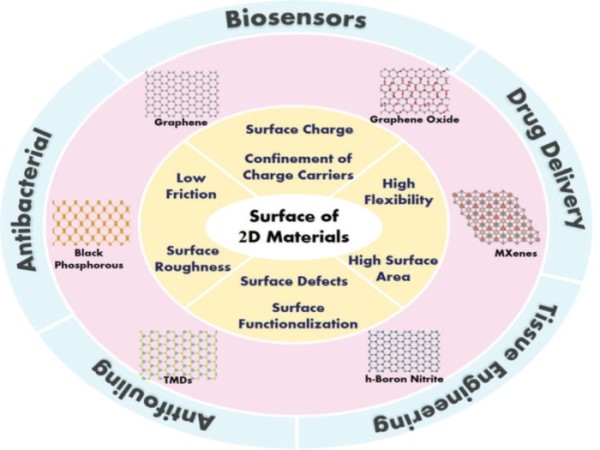Thursday, 19 November 2020
Harnessing the peculiar properties of 2D materials for biomedical applications: a review
A paper by members of the ICN2 Nanobioelectronics and Biosensors Group, led by ICREA Prof. Arben Merkoçi, and recently published in Nanoscale, discusses how the unique properties of two dimensional materials can be beneficial for biosensors and biomedical applications and provides an overview of such applications.

Thanks to their high surface area-to-volume ratios and a variety of unique and interesting properties, two dimensional (2D) materials are ideal candidates for a number of applications in different fields, spanning electronics, sensors and biosensors, information technology, energy storage and so on. The health care and biomedical field is certainly benefiting from recent developments of 2D materials research, as proven, for example, by the design and production of novel biosensing and biomedical devices based on their specific characteristics.
Recent progresses in bio-applications made possible by the use of two dimensional materials are described in a review paper recently published in Nanoscale, a journal of the Royal Society of Chemistry, and authored by Dr Emily Nguyen and group leader ICREA Prof. Arben Merkoçi, from the ICN2 Nanobioelectronics and Biosensors Group, and Prof. Cecilia de Carvalho Castro Silva, from MackGraphe - Mackenzie Presbyterian University of San Paulo (Brazil), currently visiting professor at the ICN2. The aim of this assay is to discuss the surface effects observed in current and few emerging 2D materials and how their specific properties are relevant to their employment in biosensors and biomedical devices.
Two dimensional materials are indeed made of a monolayer of atoms and, compared to the corresponding 3D counterparts, exhibit unique mechanical, chemical, electronic and optical properties. The first part of the review focuses on exploring these characteristics and explaining why they can be put into use in biosensors and biomedical devices.
Then, a panorama of these applications is provided, including: electrochemical, field effect transistors and optical biosensors; biomedical devices for antibacterial, antifouling and drug delivery applications; tissue engineering for damage repair and regeneration. Biocompatibility and biodegradability issues are also discussed. Finally, the authors provide an outlook on possible developments of this field and highlight issues and challenges to be addressed, with the aim of broadening the application of 2D materials in the biomedical field and producing commercial devices.
Article reference:
Emily P. Nguyen, Cecilia de Carvalho Castro Silva, and Arben Merkoçi, Recent advancement in biomedical applications on the surface of two-dimensional materials: from biosensing to tissue engineering. Nanoscale, 2020,12, 19043-19067. DOI: 10.1039/D0NR05287F

